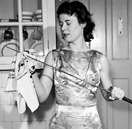
From the female gladiators of ancient Rome to The Matrix (1999) of modern Hollywood, swordswomen (both real and fictional) have fascinated audiences throughout the centuries, especially when they fight one another. Dubbed “petticoat duels,” affairs of honor between women appear to have originated in France during the mid-1600s. Historical evidence from chronicles such as Andrew Steinmetz in his Romance and History of Duelling and Robert Baldick in his modern volume The Duel suggests that women crossed steel mostly in anger. These texts offer humorous details of the particulars: Actresses challenged each other over graceless conduct on stage; a pair of quality ladies fought because one thought she was entitled to precedence of place at a society soiree; and in 1792, in the first female duel to take place in England, Lady Almeria Braddock crossed smallswords with Mrs. Elphinstone over a difference of opinion as to the former’s age.

The most intriguing duel fought between women, and the sole one that featured exposed breasts, took place in August 1892 in Verduz, the capitol of Liechtenstein, between Princess Pauline Metternich and the Countess Kielmannsegg. It has gone down in history as the first “emancipated duel” because all parties involved, including the principals and their seconds were female. Also, the confrontation was organized and presided over by the Baroness Lubinska, who had a degree in medicine (a rarity for a woman in those days) and was prepared to minister to any wounds incurred. Before the proceedings began, the baroness pointed out that many insignificant injuries in duels often became septic due to strips of clothing being driven into the wound by the point of a sword. To counter this danger she prudently suggested that both parties should fight stripped of any garments above the waist. Certainly, Baroness Lubinska was ahead of her time, taking an even more radical take on the (at the time) widely dismissed theories of British surgeon Joseph Lister, who in 1870 revolutionized surgical procedures with the introduction of antiseptic.  With the precautions Baroness Lubinska recommended, the topless women duelists were less likely to suffer from an infection; indeed, it was a smart idea to fight semiclad. Given the practicality of the baroness’ suggestion and the “emancipated” nature of the duel, it was agreed that the women would disrobe—after all, there would be no men present to ogle them. For the women, the decision to unbutton the tops of their dresses was not sexual; it was simply a way of preventing a duel of first blood from becoming a duel to the death.
With the precautions Baroness Lubinska recommended, the topless women duelists were less likely to suffer from an infection; indeed, it was a smart idea to fight semiclad. Given the practicality of the baroness’ suggestion and the “emancipated” nature of the duel, it was agreed that the women would disrobe—after all, there would be no men present to ogle them. For the women, the decision to unbutton the tops of their dresses was not sexual; it was simply a way of preventing a duel of first blood from becoming a duel to the death.
At the dueling ground on the fateful day, all formalities were carried out to the letter including an attempt at and refusal of reconciliation. The ladies engaged and, after a few trifling feints and thrusts, a wild slash from the princess brought about a light flow of blood from the countess’ nose. Seeing the injury she caused, the shocked princess, in a stereotypical feminine gesture, threw both hands up to her cheeks. Just then, the countess lunged and pierced the princess through her right forearm. The sight of the ensuing blood caused the respective seconds to faint. The footmen and coachmen, who had been ordered to stand some distance away with their backs toward the action, heard the cries and ran toward the women to render aid. Baroness Lubinska, however, decided the male servants had more salacious motives and attacked them with her umbrella, shouting, “Avert your eyes, avert your eyes—you lustful wretches!”
 The baroness was once again ahead of her time in sensing the necessary precautions. It was as if she already knew the gossip and speculation that would result from this premier example of what could have become a clothing–optional sport. (Alas, it did not—imagine the bidding wars among television networks for coverage of Olympic fencing had the baroness’ innovation stuck!) The rumors started just as soon as the Princess Metternich and Countess Kielmannsegg cast aside their weapons. Artists and storytellers speculated about the duel, most of their tales centering specifically on the scanty clothes the women wore. It is humorous that most recounts of this historic event fail to mention two important things: the winner of the duel (Princess Metternich) and the reason why the women came to arms in the first place—they disagreed over the floral arrangements for an upcoming musical exhibition. Bared breasts, apparently, overshadow such trivial details.
The baroness was once again ahead of her time in sensing the necessary precautions. It was as if she already knew the gossip and speculation that would result from this premier example of what could have become a clothing–optional sport. (Alas, it did not—imagine the bidding wars among television networks for coverage of Olympic fencing had the baroness’ innovation stuck!) The rumors started just as soon as the Princess Metternich and Countess Kielmannsegg cast aside their weapons. Artists and storytellers speculated about the duel, most of their tales centering specifically on the scanty clothes the women wore. It is humorous that most recounts of this historic event fail to mention two important things: the winner of the duel (Princess Metternich) and the reason why the women came to arms in the first place—they disagreed over the floral arrangements for an upcoming musical exhibition. Bared breasts, apparently, overshadow such trivial details.
:: Derek Ware
Female Duelists Selected Sources








